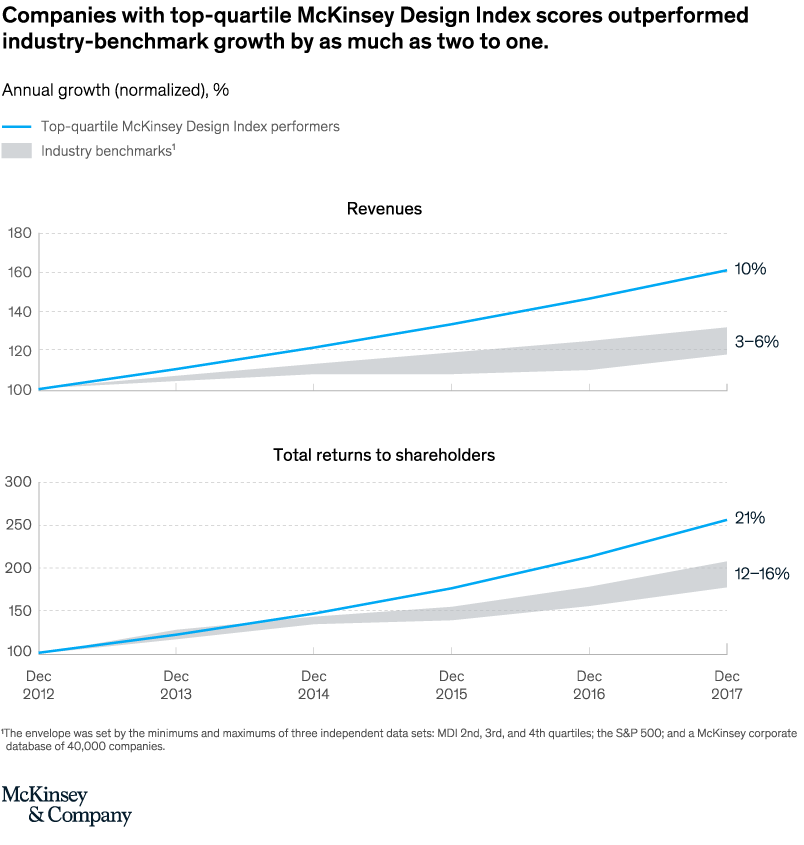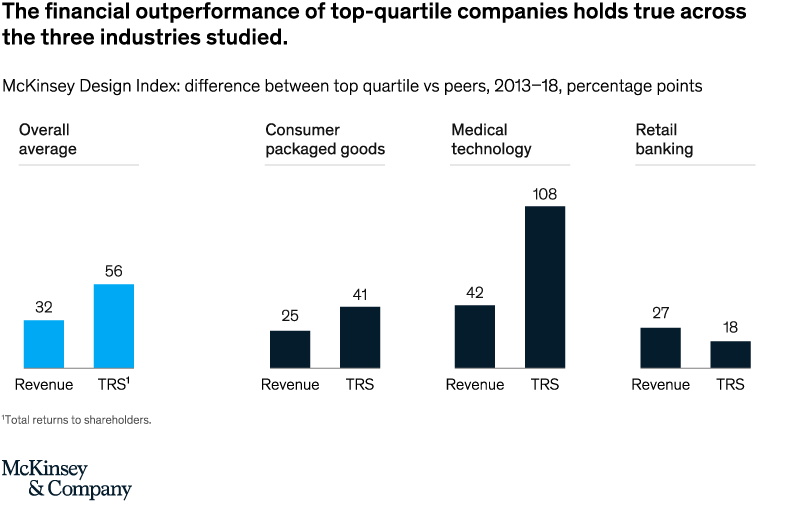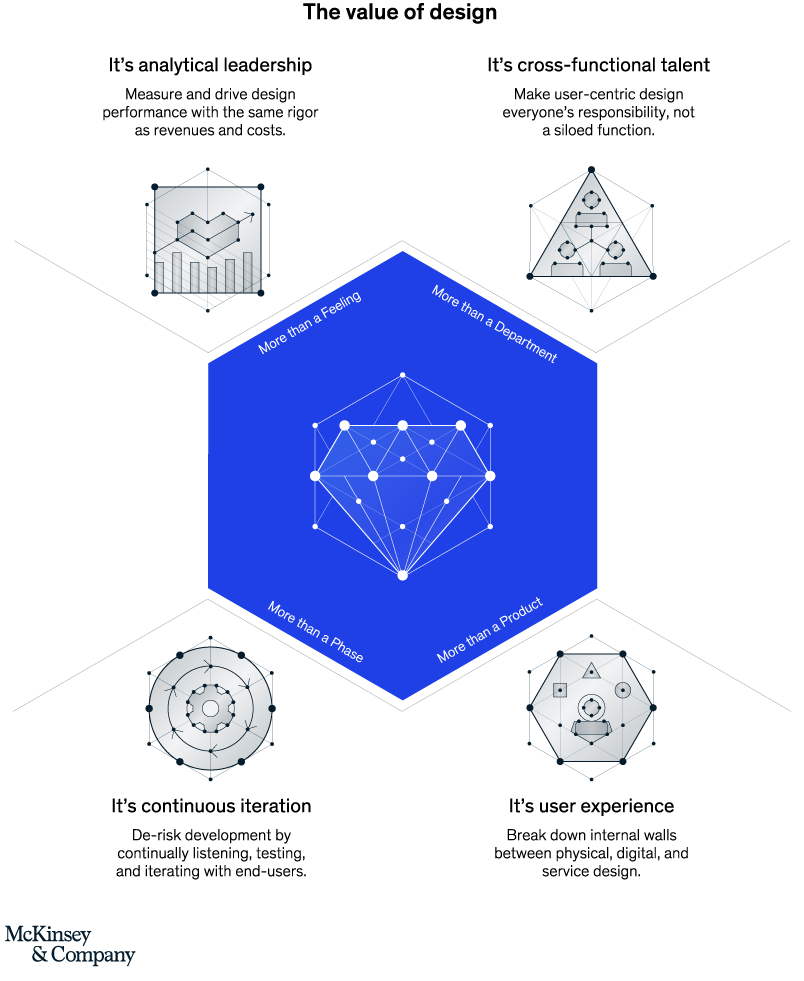
Article
Design Impact: The Future of Design & Business
How does Design impact your business? Finally, we have specific, quantifiable answers. And they point to the future of design as much as its past.
Design Impact: The Future of Design & What It Means for Business
Show me the money!
How does design impact your business? This question—or one just like it—comes up a lot. It’s a question that our clients ask frequently, and one that smart people throughout the product development industry are effectively exploring. The answers point to the future of design as much as its past—to where design is headed as well as where it’s always been.
Which is smack in the center of what matters.
At M3, we talk about stakeholder-centered design (SCD) a lot.
But it’s more than just talk. A great product needs to account for its design impact on more than just the end user. This idea is part of our DNA. And it’s a harbinger of the future of design and our industry overall.
But one of the things we don’t talk about much is the fact that design is the basic underpinning of SCD.
Sure, identifying stakeholders is critical. But it’s even more important to:
- Understand how those stakeholders interact
- Create solutions that turn those interactions into positive experiences
That’s design.
In the hyper-competitive world we live in, any perceived advantage is a plus. And anything not perceived as an advantage is a big minus.
Unfortunately, not all the organizations we interact with see design as the advantage it is. No matter how much we try to explain it, decision makers question the true impact design has on the future of their business.
The reason? It is extremely difficult to provide concrete, measurable results for design in and of itself. So historically, we have been unable to “show them the money” that results from an investment in design.
The people that “get it” almost always start with a leap of faith. And in many organizations, it’s really hard to get the right people to take that leap. That which is measurable most always rules, and the impact of design is not easily measurable.
Sigh.
Measuring design’s business impact: Attempting to quantify the unquantifiable
Not that we haven’t tried to get to hard numbers. In fact, over the years, many reports, articles, and research papers have addressed the challenge of measuring design impact.
The problem with most of them is usually that they:
- Depend on very small sample sizes
- Hinge on non-financial “soft” metrics
- Are just opinion pieces dressed up as fact
Such design-impact “research” can be used to help persuade. But in general, it doesn’t include much in the way of proof and hard numbers.
What is desperately needed is more comprehensive data that demonstrates the direct financial benefit of design. In fact, in this data-driven age, the future of design could even hinge on such proof.
Just when I thought all hope was lost, along came McKinsey & Company with a paper titled “The business value of design.” It caught my attention. Especially because they used the exhaust port on the Death Star in Star Wars as an example of poor design. Hard to argue with that.
I’m going to TL;DR it for you, but you should read it in detail when you have more time.
The (abbreviated) proof of design impact on business

First, the big deal to me is that this study:
- Was conducted over a long period of time (5 years)
- Used a large number of organizations (300)
- Used a boatload of financial data points (over 2,000,000)
In other words, this is a very significant study of design impact—not just a SurveyMonkey poll on so-and-so’s thoughts on the future of design.
McKinsey then performed advanced regression analysis on over 100,000 design actions to create a McKinsey design Index (MDI) that correlates to financial performance—aka “the money.”
To cut to the chase, of the companies surveyed, those in the top 25% of the MDI (the upper quartile) outperformed their industry benchmark growth over a five-year period by as much as two to one. Even more impressively, they had 32% better revenue growth and 56% higher total return to shareholders (TRS).
I’d call that a pretty darn good result, wouldn’t you?
Healthcare benefited the most from design impact
Interestingly, out of the three industries that McKinsey targeted in their study, healthcare medical technology businesses seemed to benefit the most. Companies in the top MDI quartile that were creating Healthcare of the Future showed 42% revenue growth and 108% TRS relative to the industry benchmark!

M3 can anecdotally support these results. Take the example of how attention to SCD paid off for our client Stryker Instruments.
When we worked with Stryker to develop their Bone Mill product, the process pointed to the future of design: stakeholder-driven research led to thoughtful innovation.
Result: Stryker went from being a non-player in the surgical bone mill market to owning it. Why? SCD = design impact on your bottom line. Enough said.
So, what is in the MDI anyway?
The MDI consists of four “themes” or clusters of design-action types. Before getting into these themes and how they impact the whole, note that in order to succeed with design:
- All four themes are required
- All four themes should be recognized and treated as interrelated
- A company should maintain a long-term commitment to the themes, as all the top performing companies in the study did
In other words, you can’t just try this on a project, be outstanding at three out of four themes, and expect great results. The study’s data clearly shows extraordinary design impact is an all-or-nothing proposition. Commit to the 4 themes, or it won’t matter.
The companies in the bottom three quartiles of the MDI showed very little difference in performance relative to their industry benchmarks.
OK, so the following basic themes, when combined, create the MDI:
- Analytical Leadership. The best organizations track their design investments, measure the results, and reinforce this throughout their organizations.
- User Experience. They focus on the product stakeholders and resolve their pain points. They don’t start with a spec!
- Cross-Functional Talent. Design is not something that only professional designers can create. It takes a cross-functional team working together to create a great product.
- Continuous Iteration. Learn, try, prototype, test, fail, and repeat until you find the solution. And do each iteration fast.

After I read McKinsey’s report, these four themes immediately appeared logical. They made total sense because they mirrored the M3 product development process! But the fact that McKinsey arrived at these themes from such a large dataset certainly provides a level of validation that I haven’t seen until now.
Plus the overall financial performance results show a compelling business case for the future of design, how it can impact a business, and why investment in it provides a strategic market advantage. Clearly, too few businesses take advantage of the potential that design provides.
I strongly encourage you to read the entire McKinsey article. Believe me, you will find it worth your time. For those instigators out there attempting to take their organizations to the next level with design, this study provides fantastic ammunition. Don’t miss out!





